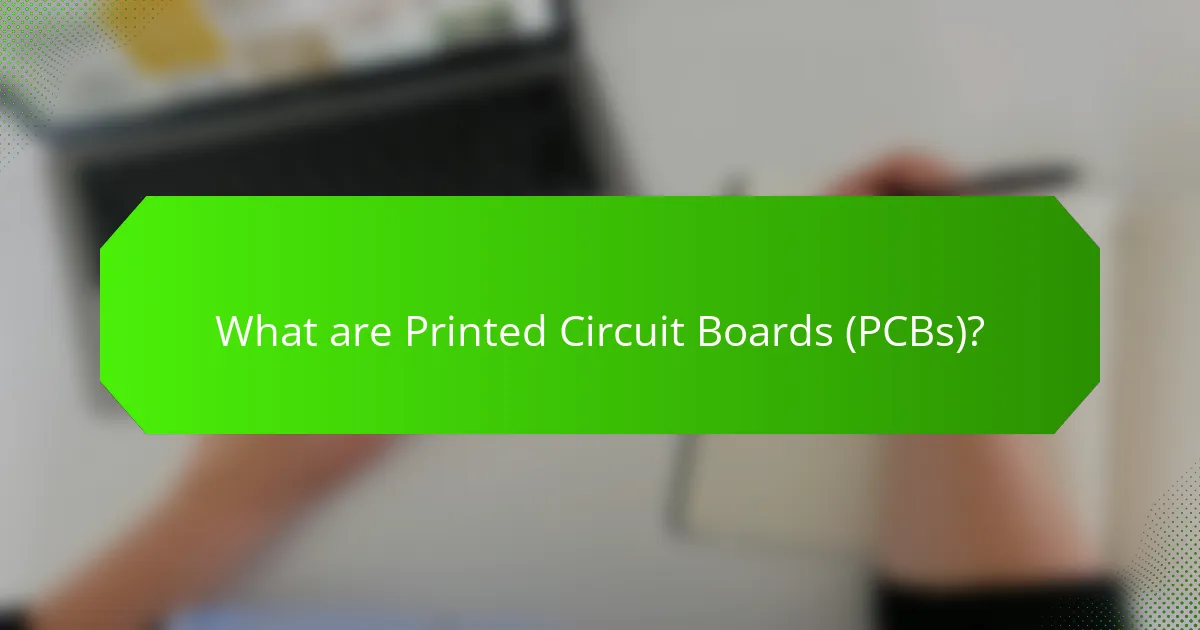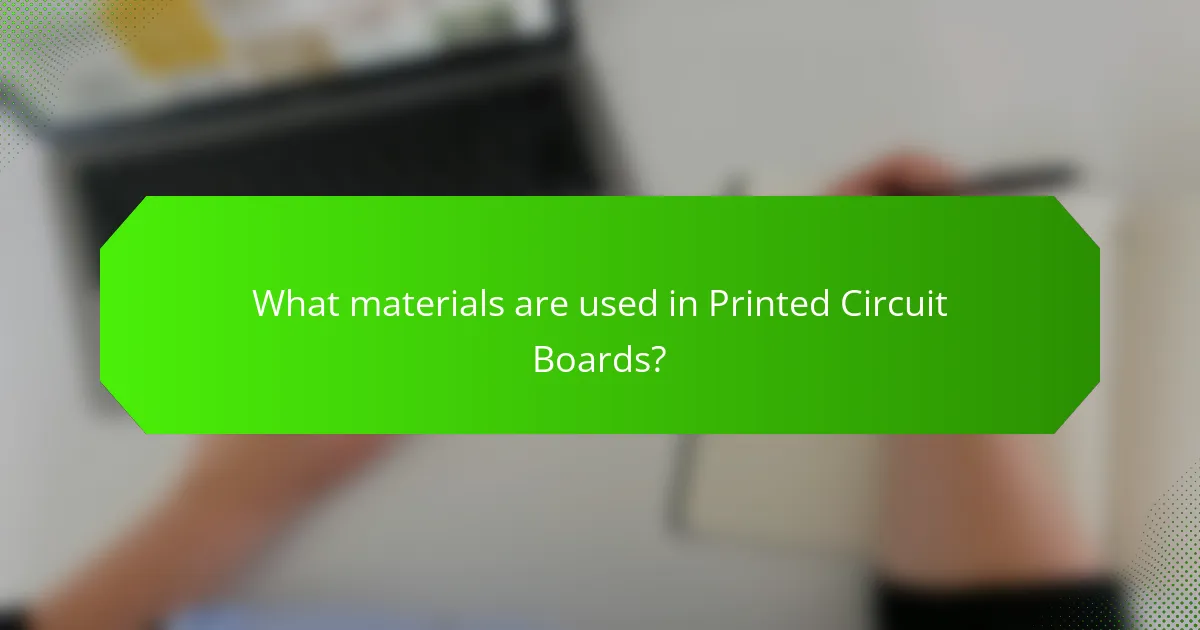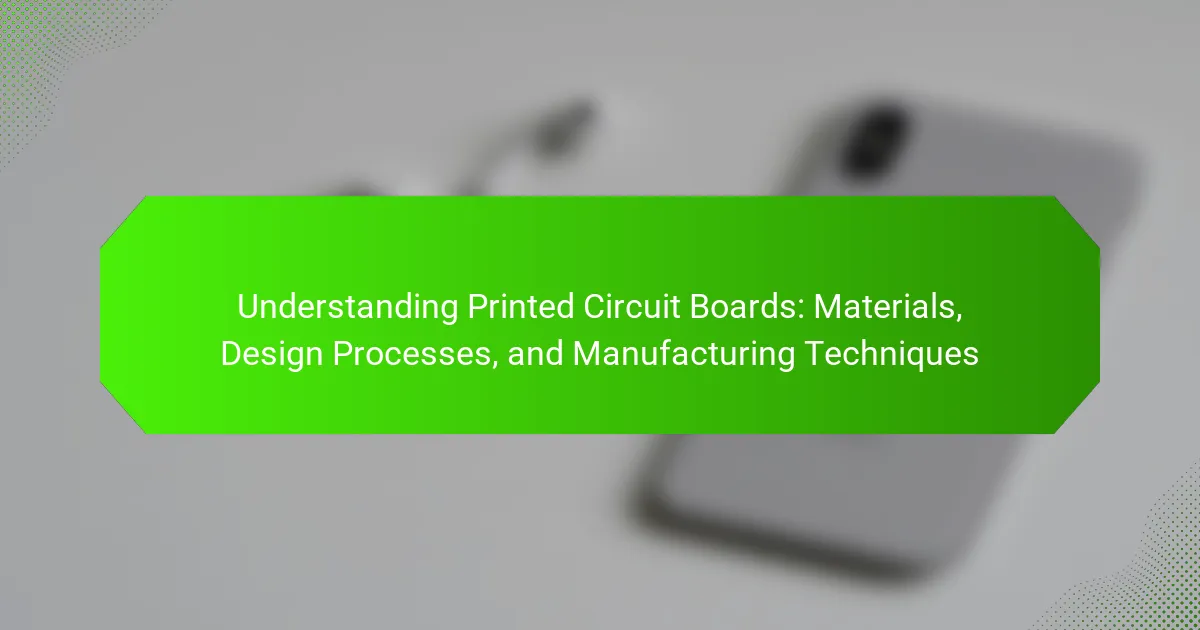Printed Circuit Boards (PCBs) are crucial components in electronic devices, serving as platforms for connecting various electronic elements through conductive pathways made of copper on a non-conductive substrate. This article provides an overview of the materials used in PCBs, including fiberglass, epoxy resin, and copper, and outlines the design processes, such as schematic capture and layout design, that ensure accurate and functional circuit representations. Additionally, it explores manufacturing techniques like subtractive, additive, and hybrid methods, which are essential for producing PCBs that meet specific electrical and mechanical requirements. The discussion emphasizes the significance of PCBs in modern technology and their role in ensuring reliable electrical connections across a wide range of applications.

What are Printed Circuit Boards (PCBs)?
Printed Circuit Boards (PCBs) are essential components used in electronic devices. They provide a platform for connecting electronic components through conductive pathways. These pathways are typically made of copper and are etched onto a non-conductive substrate. PCBs can vary in complexity from simple single-layer boards to intricate multi-layer designs. They are found in various applications, including computers, smartphones, and automotive systems. The manufacturing process involves layering materials, applying solder masks, and printing component designs. PCBs help ensure reliable electrical connections and support the overall functionality of electronic devices. Their widespread use underscores their importance in modern technology.
How do Printed Circuit Boards function in electronic devices?
Printed Circuit Boards (PCBs) function as the backbone of electronic devices. They provide a platform for mounting electronic components. PCBs connect these components through conductive pathways etched onto the board. This connectivity allows electrical signals to flow between components. The design of a PCB determines the efficiency and performance of the device. Materials used in PCBs, such as fiberglass and copper, influence their durability and conductivity. The manufacturing process involves layering, etching, and soldering components onto the board. PCBs are essential for the compact arrangement of complex electronic systems. Their role is critical in ensuring reliable operation of devices like smartphones and computers.
What are the key components of a PCB?
The key components of a PCB include the substrate, conductive traces, pads, and vias. The substrate serves as the base material, providing structural support. Common substrates are fiberglass and epoxy resin. Conductive traces are copper pathways that connect different components on the board. Pads are metal areas where electronic components are soldered. Vias are plated holes that allow connections between different layers of the PCB. These components work together to create a functional circuit board.
How do these components interact within a PCB?
Components within a PCB interact through electrical connections and signal pathways. Each component, such as resistors, capacitors, and integrated circuits, has specific roles. Resistors limit current flow, capacitors store energy, and integrated circuits process signals. These components are connected via traces on the PCB. Traces are conductive pathways that facilitate the flow of electricity between components. The layout of these traces affects the performance of the PCB. Proper design ensures minimal interference and optimal signal integrity. For example, high-speed signals require careful trace routing to reduce noise. Overall, the interaction of components is crucial for the functionality of electronic devices.
What types of Printed Circuit Boards exist?
There are several types of Printed Circuit Boards (PCBs). The main types include single-sided, double-sided, and multilayer PCBs.
Single-sided PCBs have components on one side and a conductive pattern on the other. They are commonly used in simple electronic devices. Double-sided PCBs allow components on both sides, providing more design flexibility.
Multilayer PCBs consist of multiple layers of circuitry, enabling complex configurations. They are used in advanced electronics like computers and smartphones.
Other types include flexible PCBs, which can bend and twist, and rigid-flex PCBs, which combine both rigid and flexible elements. Each type serves different applications based on design and functionality requirements.
What are the differences between single-sided, double-sided, and multi-layer PCBs?
Single-sided, double-sided, and multi-layer PCBs differ in the number of conductive layers. Single-sided PCBs have one layer of conductive material, typically copper, on one side. This design is simpler and less expensive, making it ideal for low-density applications. Double-sided PCBs feature conductive layers on both sides, allowing for more complex circuitry and better component placement. Multi-layer PCBs consist of three or more layers of conductive material, separated by insulation. This design offers high-density interconnections and is suitable for advanced electronics. The choice among them depends on the complexity and requirements of the electronic device.
How do flexible and rigid-flex PCBs compare to traditional PCBs?
Flexible and rigid-flex PCBs offer distinct advantages over traditional PCBs. Flexible PCBs can bend and twist, allowing for more compact designs in limited spaces. Rigid-flex PCBs combine both flexible and rigid elements, enhancing durability and design versatility. Traditional PCBs lack this flexibility, making them less suitable for complex applications. Flexible and rigid-flex PCBs also reduce the number of interconnects, minimizing potential failure points. In contrast, traditional PCBs often require more connectors and assembly time. The manufacturing process for flexible and rigid-flex PCBs can be more complex, but they result in lighter and thinner devices. These characteristics make flexible and rigid-flex PCBs ideal for applications in aerospace, medical devices, and consumer electronics.

What materials are used in Printed Circuit Boards?
Printed Circuit Boards (PCBs) primarily use materials such as fiberglass, epoxy resin, and copper. Fiberglass serves as the substrate, providing structural support. Epoxy resin acts as an adhesive and insulator, ensuring durability. Copper is used for conductive pathways, facilitating electrical connections. Other materials may include solder mask and silkscreen ink for protection and labeling. These materials collectively ensure the functionality and reliability of PCBs in electronic devices.
What are the common substrates used in PCB manufacturing?
The common substrates used in PCB manufacturing include FR-4, CEM-1, and polyimide. FR-4 is a glass-reinforced epoxy laminate. It is widely utilized due to its excellent mechanical properties and thermal stability. CEM-1 is a composite material made from paper and epoxy resin. It is often used for single-sided PCBs. Polyimide substrates are known for their high-temperature resistance. They are ideal for applications requiring flexibility and durability. These substrates provide the necessary support for electronic components. Their properties influence the performance and reliability of the finished PCB.
How does FR-4 compare to other substrate materials?
FR-4 is a widely used substrate material in printed circuit boards (PCBs). It offers a good balance of electrical insulation, mechanical strength, and thermal resistance. Compared to other materials like CEM-1 and CEM-3, FR-4 has superior thermal stability and dielectric properties. CEM-1 is less expensive but has lower performance in high-frequency applications. CEM-3 provides similar benefits to FR-4 but is often used for specific applications requiring better moisture resistance. In terms of cost, FR-4 is competitively priced, making it a popular choice among manufacturers. Its versatility allows for use in various electronic devices, from consumer electronics to industrial applications.
What role do copper and solder play in PCB construction?
Copper is a fundamental material in PCB construction, serving as the primary conductor for electrical signals. It forms the conductive traces that connect various components on the board. Copper is typically applied in thin layers on the substrate, allowing for efficient signal transmission.
Solder plays a crucial role in PCB assembly by joining components to the copper traces. It provides a reliable electrical connection and mechanical support for the components. When heated, solder melts and flows, creating a strong bond as it cools and solidifies.
The use of copper and solder ensures that PCBs function effectively, maintaining signal integrity and durability. These materials are essential for the overall performance and reliability of electronic devices.
What are the environmental considerations in PCB materials?
Environmental considerations in PCB materials include toxicity, recyclability, and resource depletion. PCBs often contain hazardous substances like lead, mercury, and brominated flame retardants. These materials can leach into the environment, posing risks to ecosystems and human health.
Recyclability is a significant concern. Many PCB materials are not easily recyclable, leading to increased electronic waste. According to the Global E-waste Monitor 2020, 53.6 million metric tons of e-waste were generated globally, much of which includes discarded PCBs.
Resource depletion is another factor. The production of PCBs requires raw materials such as copper and resin, which can contribute to environmental degradation. Sustainable practices, like using eco-friendly materials and improving recycling processes, are essential for minimizing these impacts.
How do lead-free materials impact PCB manufacturing?
Lead-free materials significantly impact PCB manufacturing by promoting environmental sustainability. These materials eliminate lead, a toxic substance, from the manufacturing process. This shift aligns with global regulations, such as the RoHS directive, which restricts hazardous substances in electronic equipment.
Lead-free solder typically has a higher melting point, which can affect the thermal profiles during assembly. Consequently, manufacturers may need to adjust their processes to accommodate these changes.
Additionally, lead-free materials can improve the reliability of PCBs under certain conditions. For example, they may enhance thermal fatigue resistance.
However, the transition to lead-free materials can also pose challenges. The availability of compatible components and the need for new manufacturing techniques can increase production costs.
In summary, lead-free materials drive PCB manufacturing towards safer practices while presenting both opportunities and challenges.
What are the benefits of using recyclable materials in PCBs?
Using recyclable materials in printed circuit boards (PCBs) reduces environmental impact. This practice decreases waste in landfills and conserves natural resources. Recyclable materials can lower the carbon footprint of PCB production. They often require less energy during manufacturing compared to non-recyclable alternatives. Furthermore, using these materials can enhance the sustainability profile of electronic products. Research indicates that recycling electronic waste can reclaim valuable metals and components, contributing to resource efficiency. For example, the Global e-Sustainability Initiative reported that recycling can recover up to 90% of materials from discarded electronics.

What are the design processes for Printed Circuit Boards?
The design processes for Printed Circuit Boards (PCBs) include several key stages. First, schematic capture is performed to create a visual representation of the circuit. This involves using software to draw the circuit’s components and their connections. Next, the PCB layout is designed. This step translates the schematic into a physical layout, determining the placement of components and routing of traces.
After layout design, the design undergoes a review process. This often includes Design Rule Checks (DRC) to ensure compliance with manufacturing standards. Once the design is validated, it moves to the generation of Gerber files. These files contain the necessary information for PCB fabrication.
Finally, the design is sent for manufacturing. During this stage, the PCB is produced according to the specifications outlined in the design files. Each of these stages is critical to ensure the final product functions correctly and meets quality standards.
How is a PCB designed from concept to prototype?
A PCB is designed through a systematic process from concept to prototype. The initial step involves defining the specifications and requirements of the PCB. This includes determining the function, size, and electrical characteristics needed. Next, schematic diagrams are created using PCB design software. These diagrams illustrate the connections between components.
After completing the schematic, the layout design begins. This involves placing components on the PCB and routing electrical connections. Designers must consider factors like signal integrity and thermal management during this phase. Once the layout is finalized, the design undergoes a review process to ensure accuracy.
Following approval, the PCB files are generated for manufacturing. These files include Gerber files, which specify the layers and features of the PCB. The manufacturing process then begins, which includes fabricating the board and assembling components. Finally, the prototype PCB is tested to verify its functionality and performance.
This process ensures that the PCB meets the required specifications and functions correctly in its intended application.
What software tools are commonly used in PCB design?
Common software tools used in PCB design include Altium Designer, Eagle, and KiCAD. Altium Designer is known for its advanced features and user-friendly interface. Eagle is popular among hobbyists and small projects due to its affordability. KiCAD is an open-source option that offers robust capabilities for PCB layout. Other tools include OrCAD and PSpice, which are used for simulation and analysis. These software tools facilitate schematic capture, PCB layout, and design verification. Their widespread use in the industry underscores their effectiveness in PCB design processes.
What are the critical design rules to follow when creating a PCB?
The critical design rules to follow when creating a PCB include maintaining adequate trace width and spacing. Trace width affects current-carrying capacity and must adhere to IPC-2221 standards. Proper spacing prevents short circuits and ensures signal integrity. Additionally, using a ground plane minimizes electromagnetic interference. Layer stack-up should be optimized for signal integrity and thermal management. Components must be placed to facilitate routing and minimize trace lengths. Design rules should also include proper via sizes to ensure reliability. Lastly, thorough DFM (Design for Manufacturability) checks are essential to avoid manufacturing issues. Following these rules leads to a more reliable and efficient PCB design.
What role does simulation play in PCB design?
Simulation plays a critical role in PCB design by allowing designers to predict and analyze circuit behavior before physical production. It helps in identifying potential issues such as signal integrity, thermal performance, and electromagnetic interference. By using simulation tools, designers can optimize layouts and component placements. This reduces the risk of costly errors during manufacturing. Studies show that simulation can decrease prototype iterations by up to 30%. Additionally, simulation enhances collaboration among team members by providing a visual representation of design concepts. Overall, simulation improves the efficiency and reliability of PCB design processes.
How can simulation tools help identify potential design flaws?
Simulation tools can help identify potential design flaws by allowing engineers to test and analyze their designs virtually. These tools can simulate electrical, thermal, and mechanical behaviors of printed circuit boards (PCBs). By using these simulations, designers can visualize how a PCB will perform under various conditions. This helps in detecting issues like signal integrity problems, thermal hotspots, and mechanical stress points early in the design process. For example, a study by the IEEE demonstrated that simulation can reduce prototyping costs by up to 30%. Additionally, simulation tools can provide insights that lead to design optimizations. This proactive approach minimizes the risk of costly revisions during manufacturing.
What types of simulations are most beneficial for PCB design?
Thermal, electrical, and mechanical simulations are most beneficial for PCB design. Thermal simulations assess heat distribution and dissipation in the PCB. This helps prevent overheating and ensures reliability. Electrical simulations analyze signal integrity and electromagnetic interference. They optimize the performance of the circuitry. Mechanical simulations evaluate the physical stresses on the PCB. This is crucial for durability in various environments. Each simulation type addresses specific challenges in PCB design. By using these simulations, designers can create more efficient and reliable PCBs.

What manufacturing techniques are used for Printed Circuit Boards?
Printed Circuit Boards (PCBs) are manufactured using several key techniques. The primary techniques include subtractive manufacturing, additive manufacturing, and hybrid manufacturing.
Subtractive manufacturing involves removing material from a solid substrate to create the desired circuit pattern. This is typically done through processes like etching, where unwanted copper is dissolved away.
Additive manufacturing, on the other hand, builds up the circuit layer by layer. This technique often utilizes 3D printing to deposit conductive materials in precise locations.
Hybrid manufacturing combines both subtractive and additive methods. This approach allows for greater flexibility in design and can produce complex geometries.
These techniques are essential for creating PCBs that meet specific electrical and mechanical requirements. The choice of technique depends on factors like design complexity, production volume, and cost considerations.
What are the primary methods of PCB fabrication?
The primary methods of PCB fabrication are subtractive, additive, and semi-additive processes. Subtractive fabrication involves removing material from a larger sheet to create the desired circuit pattern. This method typically includes etching techniques that use chemicals to dissolve unwanted copper. Additive fabrication builds up the circuit layer by layer, adding conductive material where needed. This method often employs printed electronics technology. Semi-additive processes combine elements of both subtractive and additive methods. They start with a thin layer of copper, which is selectively deposited on an insulating substrate. Each method has its advantages and applications in different PCB designs.
How does the etching process work in PCB manufacturing?
The etching process in PCB manufacturing removes unwanted copper from a copper-clad laminate. It begins after the desired circuit pattern is transferred onto the laminate. This is typically done using photolithography, where a photosensitive film is exposed to light through a mask.
Once the pattern is established, the PCB is immersed in an etching solution. Common etchants include ferric chloride or ammonium persulfate. These chemicals selectively dissolve the exposed copper areas.
The remaining copper forms the conductive pathways of the PCB. After etching, the PCB is rinsed to stop the chemical reaction. This process is crucial for defining the electrical connections on the board. Etching accuracy directly impacts the performance and reliability of the final product.
What is the significance of surface mount technology (SMT)?
Surface mount technology (SMT) is significant because it allows components to be mounted directly onto the surface of printed circuit boards (PCBs). This method reduces the size and weight of electronic devices. It also enables higher component density, allowing for more compact designs. SMT facilitates automated assembly processes, increasing production efficiency. The technology supports a wide range of components, including resistors, capacitors, and integrated circuits. SMT also improves electrical performance by minimizing the length of connections. Studies show that SMT can reduce manufacturing costs by up to 30%. Overall, SMT is crucial for modern electronics, driving innovation and miniaturization.
What are the quality control measures in PCB manufacturing?
Quality control measures in PCB manufacturing include visual inspection, electrical testing, and functional testing. Visual inspection checks for defects in solder joints and component placement. Electrical testing verifies circuit integrity and functionality. Functional testing evaluates the PCB’s performance in real-world conditions. Additional measures include automated optical inspection (AOI) and X-ray inspection for hidden defects. Statistical process control (SPC) monitors production processes to ensure consistency. These measures help maintain high-quality standards and reduce failure rates.
How is the reliability of PCBs tested during production?
The reliability of PCBs is tested during production through various methods. These methods include visual inspections, electrical testing, and environmental stress tests. Visual inspections check for manufacturing defects such as solder joint quality and component placement. Electrical testing involves verifying circuit functionality and continuity using automated test equipment. Environmental stress tests simulate conditions such as temperature extremes and humidity to assess PCB performance under stress. The IPC-6012 standard outlines criteria for reliability testing. Additionally, accelerated life testing can predict long-term performance by exposing PCBs to elevated stress levels. These testing methods ensure that PCBs meet required reliability standards before they are deployed in applications.
What standards govern PCB quality assurance?
The standards that govern PCB quality assurance include IPC-A-600, IPC-6012, and ISO 9001. IPC-A-600 outlines the acceptability of printed circuit boards. IPC-6012 specifies the requirements for rigid PCBs. ISO 9001 establishes a framework for quality management systems. These standards ensure consistent quality and reliability in PCB manufacturing. Compliance with these standards is critical for industry acceptance and performance.
What best practices should be followed in PCB design and manufacturing?
Best practices in PCB design and manufacturing include ensuring proper layout and spacing. Adequate clearance between traces prevents short circuits and signal interference. Using a ground plane improves signal integrity and reduces electromagnetic interference. Selecting appropriate materials is crucial for thermal management and durability. Following design rules, such as trace width and via size, enhances reliability. Conducting thorough testing, including DFM and DFT, identifies potential issues early. Finally, collaborating with manufacturers during the design phase ensures manufacturability and cost-effectiveness. These practices lead to higher quality PCBs and greater overall performance.
Printed Circuit Boards (PCBs) are critical components in electronic devices, providing a platform for connecting various electronic components through conductive pathways. This article covers the materials used in PCBs, including common substrates like FR-4 and CEM-1, and explores the design processes from schematic capture to prototype testing. It also examines the manufacturing techniques such as subtractive and additive methods, along with the significance of surface mount technology (SMT). Additionally, the article highlights quality control measures and best practices in PCB design and manufacturing to ensure reliability and performance in modern electronics.



